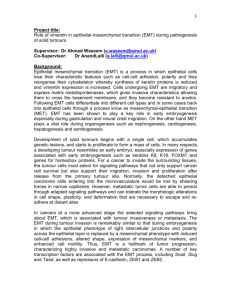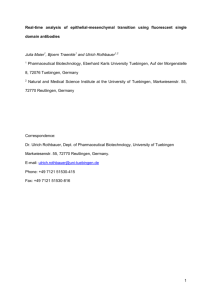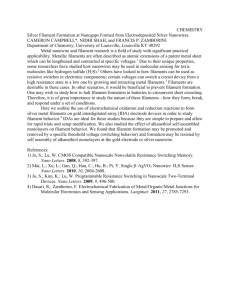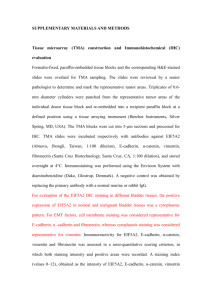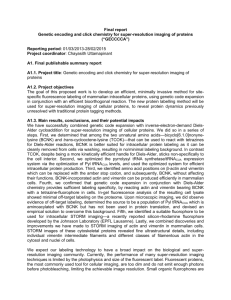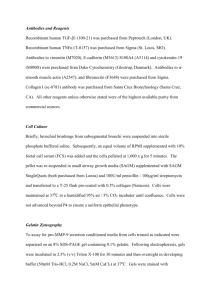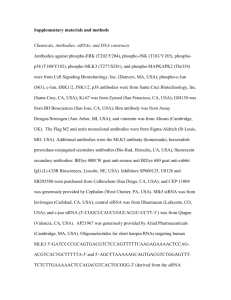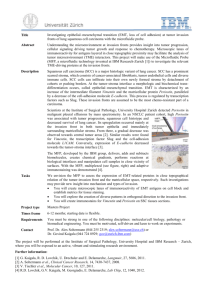Plasticin, a Type III Neuronal Intermediate Filament Protein
advertisement
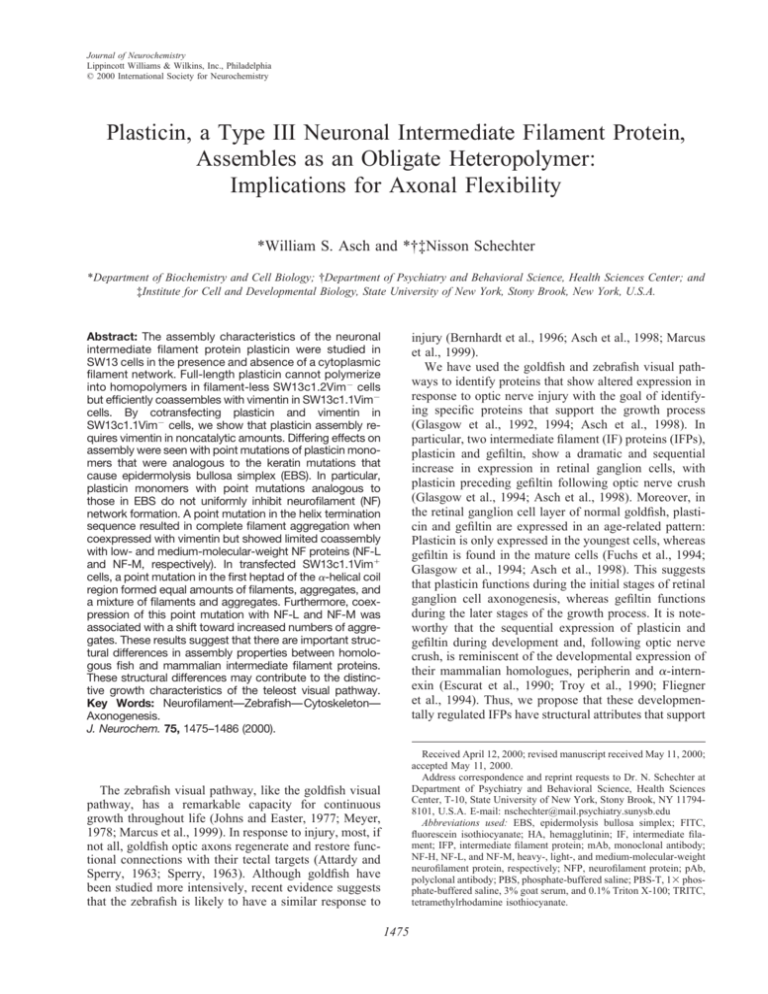
Journal of Neurochemistry
Lippincott Williams & Wilkins, Inc., Philadelphia
© 2000 International Society for Neurochemistry
Plasticin, a Type III Neuronal Intermediate Filament Protein,
Assembles as an Obligate Heteropolymer:
Implications for Axonal Flexibility
*William S. Asch and *†‡Nisson Schechter
*Department of Biochemistry and Cell Biology; †Department of Psychiatry and Behavioral Science, Health Sciences Center; and
‡Institute for Cell and Developmental Biology, State University of New York, Stony Brook, New York, U.S.A.
Abstract: The assembly characteristics of the neuronal
intermediate filament protein plasticin were studied in
SW13 cells in the presence and absence of a cytoplasmic
filament network. Full-length plasticin cannot polymerize
into homopolymers in filament-less SW13c1.2Vim⫺ cells
but efficiently coassembles with vimentin in SW13c1.1Vim⫺
cells. By cotransfecting plasticin and vimentin in
SW13c1.1Vim⫺ cells, we show that plasticin assembly requires vimentin in noncatalytic amounts. Differing effects on
assembly were seen with point mutations of plasticin monomers that were analogous to the keratin mutations that
cause epidermolysis bullosa simplex (EBS). In particular,
plasticin monomers with point mutations analogous to
those in EBS do not uniformly inhibit neurofilament (NF)
network formation. A point mutation in the helix termination
sequence resulted in complete filament aggregation when
coexpressed with vimentin but showed limited coassembly
with low- and medium-molecular-weight NF proteins (NF-L
and NF-M, respectively). In transfected SW13c1.1Vim⫹
cells, a point mutation in the first heptad of the ␣-helical coil
region formed equal amounts of filaments, aggregates, and
a mixture of filaments and aggregates. Furthermore, coexpression of this point mutation with NF-L and NF-M was
associated with a shift toward increased numbers of aggregates. These results suggest that there are important structural differences in assembly properties between homologous fish and mammalian intermediate filament proteins.
These structural differences may contribute to the distinctive growth characteristics of the teleost visual pathway.
Key Words: Neurofilament—Zebrafish—Cytoskeleton—
Axonogenesis.
J. Neurochem. 75, 1475–1486 (2000).
injury (Bernhardt et al., 1996; Asch et al., 1998; Marcus
et al., 1999).
We have used the goldfish and zebrafish visual pathways to identify proteins that show altered expression in
response to optic nerve injury with the goal of identifying specific proteins that support the growth process
(Glasgow et al., 1992, 1994; Asch et al., 1998). In
particular, two intermediate filament (IF) proteins (IFPs),
plasticin and gefiltin, show a dramatic and sequential
increase in expression in retinal ganglion cells, with
plasticin preceding gefiltin following optic nerve crush
(Glasgow et al., 1994; Asch et al., 1998). Moreover, in
the retinal ganglion cell layer of normal goldfish, plasticin and gefiltin are expressed in an age-related pattern:
Plasticin is only expressed in the youngest cells, whereas
gefiltin is found in the mature cells (Fuchs et al., 1994;
Glasgow et al., 1994; Asch et al., 1998). This suggests
that plasticin functions during the initial stages of retinal
ganglion cell axonogenesis, whereas gefiltin functions
during the later stages of the growth process. It is noteworthy that the sequential expression of plasticin and
gefiltin during development and, following optic nerve
crush, is reminiscent of the developmental expression of
their mammalian homologues, peripherin and ␣-internexin (Escurat et al., 1990; Troy et al., 1990; Fliegner
et al., 1994). Thus, we propose that these developmentally regulated IFPs have structural attributes that support
Received April 12, 2000; revised manuscript received May 11, 2000;
accepted May 11, 2000.
Address correspondence and reprint requests to Dr. N. Schechter at
Department of Psychiatry and Behavioral Science, Health Sciences
Center, T-10, State University of New York, Stony Brook, NY 117948101, U.S.A. E-mail: nschechter@mail.psychiatry.sunysb.edu
Abbreviations used: EBS, epidermolysis bullosa simplex; FITC,
fluorescein isothiocyanate; HA, hemagglutinin; IF, intermediate filament; IFP, intermediate filament protein; mAb, monoclonal antibody;
NF-H, NF-L, and NF-M, heavy-, light-, and medium-molecular-weight
neurofilament protein, respectively; NFP, neurofilament protein; pAb,
polyclonal antibody; PBS, phosphate-buffered saline; PBS-T, 1⫻ phosphate-buffered saline, 3% goat serum, and 0.1% Triton X-100; TRITC,
tetramethylrhodamine isothiocyanate.
The zebrafish visual pathway, like the goldfish visual
pathway, has a remarkable capacity for continuous
growth throughout life (Johns and Easter, 1977; Meyer,
1978; Marcus et al., 1999). In response to injury, most, if
not all, goldfish optic axons regenerate and restore functional connections with their tectal targets (Attardy and
Sperry, 1963; Sperry, 1963). Although goldfish have
been studied more intensively, recent evidence suggests
that the zebrafish is likely to have a similar response to
1475
1476
W. S. ASCH AND N. SCHECHTER
the staged growth of optic axons during development and
regeneration.
Although plasticin was originally discovered in the
teleost visual pathway, it is also transiently expressed in
other neurons during zebrafish development (Canger
et al., 1998). In particular, plasticin expression is detected in restricted subsets of projection neurons that
pioneer distinct axon tracts in the embryo. These developmental studies further indicate that plasticin has structural attributes that subserve the morphology of the neuron during its early growth phase.
Structurally, plasticin is a type III IFP (Geisler et al.,
1983). As such, it has specific amino acid sequences and
a structural organization that is similar to those of other
cytoplasmic IFPs. To determine whether the plasticin
protein can influence the organization of an IF network
and, if so, determine which regions of the protein contribute, we turned to the keratins, another IFP type for
which significant structure–function information is available.
In humans, keratin mutations are associated with diseases such as epidermolysis bullosa simplex (EBS) and
epidermolytic hyperkeratosis (reviewed by Coulombe,
1993). Although the exact mechanism is unclear, mutant
keratin monomers disrupt keratin networks by interfering
with some stage of the assembly process. Extensive
studies on filament assembly in vitro suggest that something goes awry during the progression from tetramers to
protofilaments during polymerization (Letai et al., 1992).
Most of the natural point mutations recovered to date
suggest that interactions between adjacent ␣-helices are
affected (Chan et al., 1996). Of usefulness to plasticin
function studies in zebrafish is the dominant-negative
action these mutant keratin subunits possess. They are
able to pair with endogenous subunits to form the lowerorder dimeric and tetrameric structures but are unable to
assemble into higher-order structures (Fuchs and Coulombe, 1992). Thus, these mutant subunits can effectively draw normal subunits out of the monomer pool
and prevent their assembly into filamentous structures
(Fuchs and Coulombe, 1992). However, despite the
highly conserved nature of the ␣-helical coil domain, we
could not assume that all IFPs with equivalent mutations
will behave like keratin. Nonetheless, these disease-producing keratin mutations provide methodological insights into studies of IFP structure and function during
neurogenesis.
We engineered cDNAs that encode plasticin monomers having point mutations that are homologous to two
of the mutant keratin K14 genes, commonly found in
patients with EBS. Preliminary microinjection studies,
using mRNA transcribed from these cDNAs in vitro,
showed gross developmental defects in some injected
zebrafish embryos. However, these defects were difficult
to interpret because it was not known whether plasticin
would promiscuously coassemble into nonneuronal IF
networks. Furthermore, our preliminary studies did not
allow us to follow transgenic protein that was ectopically
expressed after microinjection. Before plasticin microinJ. Neurochem., Vol. 75, No. 4, 2000
jection studies in zebrafish embryos could be interpreted,
a detailed analysis in a defined cellular environment was
needed.
SW13 cells offer a unique cellular context in which IF
assembly can be assessed. The mosaic expression of
vimentin, the only cytoplasmic IF expressed in SW13
cells, was first recognized by Hedberg and Chen (1986).
Subsequently, highly related subcultures of SW13 cells
were isolated based on the presence or absence of vimentin expression (Sarria et al., 1994). Although these
cultures are not pure, they do provide an experimental
cell system that is virtually free of cytoplasmic IF expression. Thus, the assembly properties of wild-type and
mutant IF subunits can be determined in isolation or in
the context of IF reconstituted cells (Cui et al., 1995; Sun
et al., 1997; Ching and Liem, 1999).
In this report, we show that plasticin, unlike its mammalian homologue peripherin, is unable to form a homopolymeric IF network in SW13 cells. Rather, plasticin
forms dense cellular aggregates in cells lacking an IF
cytoskeleton. However, plasticin does polymerize to
form an IF network in vimentin-containing cells. Furthermore, plasticin subunits bearing EBS point mutations
at the end of the ␣-helical coil domain show assembly
defects in the presence of vimentin, but, surprisingly,
vimentin polymerization is apparently not affected to the
same degree. Moreover, the plasticin point mutation at
the beginning of the ␣-helical coil domain is largely
rescued by cotransfection with the low- and mediummolecular-weight neurofilament proteins (NFPs) (NF-L
and NF-M, respectively).
MATERIALS AND METHODS
Cell culture
Human adrenal carcinoma SW13 c1.1Vim⫹ and SW13
c1.2Vim⫺ cells were generously provided by Dr. Robert Evans
(University of Colorado Health Sciences Center, Denver, CO,
U.S.A.). Cells were grown in a 1:1 mixture of Dulbecco’s
modified Eagle’s medium and Ham’s F12 (GibcoBRL, Gaithersburg, MD, U.S.A.) supplemented with 5% fetal bovine serum, 100 U/ml penicillin G sodium, and 100 g/ml streptomycin sulfate. All cells were maintained at 37°C, or 32°C where
noted, in a humidified atmosphere supplemented with 5% CO2.
DNA constructs
Mutations in plasticin (Asch et al., 1998) were generated by
in vitro mutagenesis using the method described by Kunkel
(1985). In brief, plasmids were transformed into the Escherichia coli strain CJ236 to yield single-stranded, uracil-containing circular DNA using the M13K07 helper phage. Singlestranded plasmid was purified from the helper phage by preparative gel electrophoresis. Phosphorylated oligonucleotides
containing internal mutations (synthesized by Genosys Biotechnologies, The Woodlands, TX, U.S.A.) were hybridized to
the single-stranded plasmid and extended with T7 DNA polymerase. The resulting double-stranded plasmid was transformed into E. coli strain XL1-Blue MRF⬘ (Stratagene, La
Jolla, CA, U.S.A.). Appropriate mutations were identified by
sequencing DNA obtained from mini-preps (RPM kit; Bio 101,
Vista, CA, U.S.A.) as described previously (Asch et al., 1998).
All plasticin cDNAs were subsequently cloned as HindIII–
PLASTICIN ASSEMBLY CHARACTERISTICS
1477
EcoRI fragments into pBluescript P/X HA3 (Neiman et al.,
1997) using standard PCR techniques. These plasticin– hemagglutinin (HA) tag fusion cDNAs were then cloned as HindIII–
XbaI fragments into the mammalian expression vector
pcDNA3.1 (Invitrogen, San Diego, CA, U.S.A.). Untagged
plasticin cDNAs were cloned as EcoRI–XbaI fragments into
pCS2⫹ (Rupp et al., 1994; Turner and Weintraub, 1994) using
standard PCR techniques. Plasmids used for transfection were
purified using the Plasmid Maxi Kit (Qiagen, Hilden, Germany). The pRSVi-NF-L, pRSVi-NF-M, and pRSVi-vimentin
expression constructs (Chin and Liem, 1989; Sun et al., 1997)
were generously provided by Dr. Ronald H. K. Liem (Columbia University College of Physicians and Surgeons, New York,
NY, U.S.A.). The VimGG⫹D expression construct (Beuttenmuller et al., 1994) was kindly provided by Drs. Peter Traub
and Robert Shoeman (Max Planck Institute for Cell Biology,
Ladenburg, Germany).
at room temperature with gentle shaking. Cells were once again
washed four times with PBS for 5 min to remove unbound
secondary antibody. Coverslips were mounted wet, using 12 l
of aqueous antifade solution {10 mg/ml diazabicyclo[2.2.2.]octane
(Sigma), 90% glycerol, and 1⫻ PBS, pH 8.6}, and sealed using
conventional nail polish. Cells were stored in the dark overnight at room temperature and viewed using a 95⫻ fluorescence objective (Leitz, Wetzlar, Germany) on an IMT-2 inverted fluorescence microscope equipped with a PM-30 exposure control unit (Olympus, Melville, NY, U.S.A.). All images
were captured on Ektachrome 400 positive film (Eastman
Kodak, Rochester, NY, U.S.A.) and scanned into a personal
computer (Dell Computer, Round Rock, TX, U.S.A.) using a
SprintScan 35 Plus (Polaroid, Cambridge, MA, U.S.A.) slide
scanner. Images were captured at the highest resolution possible (2,700 dpi) and processed using Photoshop (version 4.0;
Adobe Systems, San Jose, CA, U.S.A.).
DNA transient transfections
Cell extractions and immunoblot analysis
SW13 cells were transfected using the nonliposomal lipid
formulation Fugene 6 (Boehringer Mannheim Biochemicals,
Indianapolis, IN, U.S.A.) according to the manufacturer’s instructions. In brief, 18 h before transfection, cells were split and
plated into 35-mm-diameter culture dishes that contained a
sterile 22-mm square coverslip. Cells were grown overnight to
⬃30% confluence. DNA was complexed with Fugene 6 at a
ratio of 1:3 (g:l) in 100 l of serum-free Dulbecco’s modified Eagle’s medium for 15 min and added directly to the
overnight cultures. Cells were allowed to grow under the transfection conditions for an additional 24 –36 h, after which they
were fixed for immunocytochemistry. All transfections were
repeated a minimum of two times.
Antibodies
The anti-plasticin (clone CL3) polyclonal antibody (pAb)
has been described previously (Fuchs et al., 1994) and was used
at a dilution of 1:1,000 for immunohistochemistry. The antivimentin monoclonal antibody (mAb) was used at a dilution of
1:100 (clone V9; Sigma Chemical Co., St. Louis, MO, U.S.A.).
The anti-NF-L and anti-NF-M mAbs (clones NR4 and NN18,
respectively) were also obtained from Sigma and used at a
dilution of 1:250. The anti-HA mAb (clone 12CA5; Boehringer
Mannheim Biochemicals) was used at 1.6 g/ml. Secondary
antibodies included goat anti-mouse IgG1 pAb conjugated with
fluorescein isothiocyanate (FITC), goat anti-mouse IgG2b pAb
conjugated with tetramethylrhodamine isothiocyanate (TRITC),
goat anti-rabbit IgG (heavy and light chain) pAb conjugated
with FITC, and goat anti-rabbit IgG (heavy and light chain)
pAb conjugated with TRITC. The goat anti-mouse pAbs were
used at a dilution of 1:500. The goat anti-rabbit pAbs were used
at a dilution of 1:250. Secondary antibodies were obtained from
Southern Biotechnology Associates (Birmingham, AL, U.S.A.).
All antibodies were diluted in phosphate-buffered saline (PBS)
supplemented with 3% serum.
Immunocytochemistry
Following transfection, cultures were rinsed three times with
PBS (deficient in Ca2⫹ and Mg2⫹) and then fixed in cold
methanol for 10 min at ⫺20°C. After four 5-min washes with
PBS, the cells were blocked for 30 min in PBS supplemented
with 3% serum. Cells were subsequently washed with PBS and
incubated with primary antibody for 1 h at room temperature
with gentle shaking. To remove unbound primary antibody,
cells were washed four times with PBS for 5 min. Cells were
then incubated with secondary antibody for 30 min in the dark
Cell extracts from 100-mm-diameter plates were prepared,
as previously described (Ching and Liem, 1993), using 2 ml of
lysis buffer. Proportional amounts of the Triton X-100-insoluble fraction from SW13c1.1Vim⫹ and SW13c1.2Vim⫺ cells
were electrophoresed in sodium dodecyl sulfate-10% polyacrylamide gels and were electrotransferred to polyvinylidene
difluoride membranes. Membranes were blocked overnight in
PBS containing 0.1% Triton X-100 and 5% powdered milk.
The CL3 pAB was used at a dilution of 1:5,000 in PBS-T (1⫻
PBS, 3% goat serum, and 0.1% Triton X-100) for western
blots. The goat anti-rabbit alkaline phosphatase-conjugated secondary antibody (Sigma) was used at 1:10,000 in PBS-T. The
blot was developed using the NBT (nitro blue tetrazolium) and
BCIP (5-bromo-4-chloro-3-indolyl phosphate) alkaline phosphatase substrates (GibcoBRL) and processed as described
above.
RESULTS
Plasticin is unable to form normal homopolymeric
IF networks in SW13 cells
Transfection of mammalian expression constructs into
SW13c1.2Vim⫺ cells is a reliable system for assessing
the homopolymer-forming properties of IFPs. Therefore,
we determined whether zebrafish plasticin can assemble
to form a cytoplasmic IF network, in the absence of any
other IFPs, by introducing plasmid pCS2⫹PlastB-ORF
(Fig. 1) into SW13c1.2Vim⫺ cells using the nonliposomal lipid formulation Fugene 6. After 24 –36 h of incubation, cells were fixed, and plasticin expression was
visualized by fluorescence immunohistochemistry using
the CL3 pAb. Nonfilamentous aggregates were found in
nearly all of the fluorescently labeled cells (Fig. 2A).
Typically, aggregates varied in size between cells as well
as within a single cell. This staining pattern is distinct
from the diffuse staining that would be likely in the
presence of stable monomers. Furthermore, these aggregations are not soluble in 1% Triton X-100, indicating
that filament assembly may have proceeded beyond tetrameric structures (Fig. 3). Very rarely, a cell could be
found that demonstrated plasticin homopolymer assembly. Because 1% of cells in SW13c1.2Vim⫺ cultures
express vimentin (Sarria et al., 1994), cells that contained
J. Neurochem., Vol. 75, No. 4, 2000
1478
W. S. ASCH AND N. SCHECHTER
FIG. 1. Schematic illustration of the full-length, point mutation, and deletion plasticin constructs used in these studies. The locations of
head, rod, and tail domains and HA3 epitope tags are indicated. Amino acid sequences in the vicinity of the point mutations are shown
with the one-letter code, and the mutated amino acid is shown in bold. Amino acid sequences at the deletion junctions are also shown,
and additional amino acid residues generated during cloning are underlined. Note that the PlastB-⌬C417 construct is truncated before
the RGD sequence and that the PlastB-⌬C366 construct is truncated 5⬘ of the KLEGEE sequence.
plasticin filaments were most likely vimentin-expressing
mosaic cells in the SW13c1.2Vim⫺ culture. These results indicated that wild-type plasticin is unable to polymerize into homopolymeric IFs but would be able
to heteropolymerize with vimentin. Indeed, when
pCS2⫹plasticin was transfected into SW13c1.2Vim⫹,
plasticin protein assembled into the filamentous architecture characteristic of IFs (Fig. 2B).
At 37°C, trout, Xenopus, and zebrafish vimentins are
unable to self-assemble to form normal filamentous networks in cultured cells (Herrmann et al., 1993, 1996;
Cerda et al., 1998). However, this assembly defect is
temperature-dependent because IF polymerization ocJ. Neurochem., Vol. 75, No. 4, 2000
curs when cultures are cooled below 34°C (Cerda et al.,
1998). To determine whether plasticin self-assembly is
similarly temperature-dependent, we transiently transfected and cultured SW13c1.2Vim⫺ cells with
pCS2⫹PlastB-ORF at 32°C. SW13 cells grown for 24 h
at 32°C displayed normal morphology and did not release from the culture plate. No visual difference between these cells and SW13 cells grown at 37°C was
apparent. In nearly all cells, we observed diffuse cytoplasmic staining and filament aggregation (Fig. 2C).
Rarely, we identified a cell in which plasticin polymerized into extremely short, disconnected structures (Fig.
2D). Because plasticin did not homopolymerize at 32°C,
PLASTICIN ASSEMBLY CHARACTERISTICS
1479
FIG. 2. Immunofluorescence of SW13 cells
transiently transfected with pCS2⫹ORF.
A: Plasticin is unable to form a normal filamentous homopolymer in SW13c1.2Vim⫺
cells. B: Plasticin is able to coassemble
with vimentin in SW13c1.1Vim⫹ cells.
The inability of plasticin to self-assemble
in SW13c1.2Vim⫺ cells is not a function
of the assembly temperature. C: Plasticin is unable to self-assemble in
SW13c1.2Vim⫺ cells at 32°C. D: In rare
cases, plasticin polymerized into extremely short, disconnected structures
in SW13c1.2Vim⫺ cells at 32°C. Bar
⫽ 20 m.
a temperature predicted to be permissive for zebrafish
filament assembly, its self-assembly is not temperaturedependent under the conditions described here.
Plasticin assembly is unimpeded by addition of the
HA tag to the carboxy terminus
Our studies in developing zebrafish embryos use an
epitope-tagged form of plasticin to discriminate between
expression of endogenous and microinjected plasticin.
An added advantage of epitope tagging is that plasticin
can be visualized immunohistochemically, yet antibody
cross-reactivity with similar IFPs is eliminated. To visualize microinjected plasticin protein, three tandem copies
of the HA antigen epitope were inserted, in frame, at the
C terminus. The resulting clones were further subcloned
into the expression vector pcDNA3.1 and expressed in
vitro to ensure that the clones produced full-length, inframe proteins (data not shown). When PlastBHA3 (Fig.
1) is introduced into SW13 cells, the results are identical
to those obtained with pCS2⫹PlastB-ORF, namely, plasticin is able to form normal-appearing IF networks in
cells expressing vimentin (Fig. 4A) but is unable to
self-assemble in vimentin-free cells (Fig. 4B). Thus,
addition of the triple HA tag does not impede plasticin
filament coassembly with vimentin. Furthermore, using
dual labeling of SW13c1.2Vim⫹ cells, it is clear that
PlastBHA3 coassembles with vimentin to form filament
networks (Fig. 4C and D). Attempts to tag plasticin with
the c-myc and FLAG epitopes at the N terminus blocked
FIG. 3. Immunoblot of the Triton
X-100-insoluble fractions from SW13
cells. Following transient transfection
in SW13c1.2Vim⫺ (lane 1) and
SW13C1.1Vim⫹ (lane 2) cells, plasticin
is found in the Triton X-100-insoluble
fraction. The plasticin CL3 pAb was
used for detection. The cell extract of
nontransfected SW13c1.1Vim⫹ cells
was used as a negative control (lane 3).
assembly in vimentin-positive SW13 cells (authors’ unpublished data).
The requirement of vimentin for assembly
is not catalytic
Having determined that plasticin can form filament
networks in SW13c1.2Vim⫹ but not SW13c1.2Vim⫺
cells, we investigated whether catalytic quantities of
vimentin are sufficient for coassembly. Vimentin-free
SW13 cells were cotransfected with plasticin and vimentin expression constructs at varying molar ratios but with
a fixed total amount of transfected plasmid. When cotransfected at a ratio of 100:1 (plasticin:vimentin) all of
the cells formed aggregates (Fig. 5A). However, when
the amount of vimentin is increased to a ratio of 100:10,
a clear difference in staining is observed (Fig. 5B).
Plasticin is still aggregated in about half of the transfected cells. The other half of the cells show plasticin
forming spherical cytoplasmic aggregates that are often
in connection with some short, loosely packed filamentous structures. These aggregates were of a smaller size
when compared with those typically formed by cotransfecting plasticin with vimentin at a ratio of 100:1 in
SW13c1.2Vim⫺ cells. This “ball and chain” phenotype
was previously reported using point mutations of vimentin, namely, VimKK⫹D and VimKR⫹D (Beuttenmuller
et al., 1994). However, little is known about the assembly dynamics that produce these structures. When plasticin and vimentin expression plasmids are cotransfected
at equivalent molar levels, the phenotype is still different
(Fig. 5C). These cells have cytoplasmic IF networks that
vary in density and length. Some are loosely packed like
the filaments formed at the 100:10 ratio, but others
resemble normal IF networks. Similarly, some of the
filaments are very short, whereas others appear to be of
normal length.
Having determined that plasticin assembly is qualitatively dose-dependent but not reliant on vimentin in
catalytic amounts, we sought to determine whether plasJ. Neurochem., Vol. 75, No. 4, 2000
1480
W. S. ASCH AND N. SCHECHTER
FIG. 4. Addition of the HA3 epitope tag
does not alter the assembly properties of
plasticin in SW13 cells. PlastBHA3 forms
normal filaments in SW13c1.1Vim⫹ cells
(A) but is unable to self-assemble in
SW13c1.2Vim⫺ cells (B). A dual-labeling
immunofluorescence assay shows that
plastBHA3 (C) colocalizes with vimentin
(D) in SW13c1.1Vim⫹ cells. Bar ⫽
20 m.
ticin assembly requires vimentin assembly or whether
some other structural feature of vimentin could be involved. For example, the vimentin “head,” alone, might
be sufficient for the plasticin assembly process, even if
vimentin itself is unable to assemble. To determine
whether threshold amounts of vimentin or a subdomain
of vimentin is required, even in the absence of vimentin
assembly, we cotransfected equivalent quantities of
PlastBHA3 with the assembly-defective vimentin expression vector VimGG⫹D (Beuttenmuller et al., 1994).
Analysis of these cells showed that plasticin does not
assemble even with addition of high quantities of an
assembly-defective vimentin subunit (Fig. 5D). Thus, it
appears that the ability of plasticin to coassemble in
vimentin-containing cells depends on the ability of vimentin to assemble. Furthermore, this dependence is not
catalytic in that small quantities of assembly-competent
vimentin cannot lead to complete plasticin polymerization.
Carboxyl-terminally truncated plasticin protein is
able to form IF networks in SW13c1.1Vimⴙ
Carboxyl-terminal deletion mutants of NF-L and NFM show a dominant-negative effect on the assembly of
vimentin in cultured mouse fibroblast L cells. Similarly,
expression of tailless peripherin mutants in SW13c1.1Vim⫹
cells disrupted the entire vimentin IF network. However,
this has not been a universal property of all IFs. For
example, carboxyl-terminal deletion mutants of desmin
had no detectable impairment of polymerization. To determine whether plasticin mutants would behave like
desmin or like NF-L, NF-M, and peripherin, we transfected SW13c1.1Vim⫹ cells with a carboxyl-terminal
deletion mutant of plasticin, PlastB-⌬C366 (Fig. 1). This
construct does not contain the region against which the
plasticin antibody was raised, and we did not want to
confound the carboxyl-terminal deletion analysis by adding a carboxyl-terminal HA tag. Consequently, we visualized PlastB-⌬C366 filament networks via copolymer-
FIG. 5. The requirement of vimentin for
plasticin assembly is not catalytic. A: Cotransfection of plasticin (PlastBHA3) and vimentin at a ratio of 100:1, respectively,
produced aggregates in SW13C1.2Vim⫺
cells. B: Cotransfection at a ratio of 10:1
resulted in both filament formation and aggregation, with some cells having filaments with a “ball and chain” appearance.
C: When equimolar quantities of plasticin
and vimentin expression constructs were
cotransfected, the cytoplasmic IF networks produced varied in filament length
and density. D: Cotransfection of equimolar amounts of plasticin and assembly-defective VimGG⫹D expression constructs
does not result in coassembly. Bar ⫽
20 m.
J. Neurochem., Vol. 75, No. 4, 2000
PLASTICIN ASSEMBLY CHARACTERISTICS
1481
FIG. 6. Coassembly of C-terminal deletion mutants of plasticin with vimentin.
A: Deletion of the entire tail and helix
termination sequence renders plasticin
unable to coassemble with vimentin.
B: Furthermore, vimentin assembly is
adversely affected. Deletion of the plasticin tail up to, but not including, the RDG
motif does not alter coassembly of plasticin (C) and vimentin (D) in most cells.
Bar ⫽ 20 m.
ization with trace amounts of PlastBHA3 using the antiHA mAb. Without the entire tail and helix termination
sequence from coil 2b, PlastB-⌬C366 is unable to form
normal filament networks in transfected cells (Fig. 6A).
Furthermore, the aggregates that formed in these
SW13c1.1Vim⫹ cells contained plasticin and most of the
vimentin in the cell (Fig. 6B). Therefore, PlastB-⌬C366
is unable to coassemble with vimentin and also interferes
with vimentin assembly in a dominantly negative fashion. However, PlastB-⌬C417, a plasticin cDNA that
encoded a subunit that contained the tail up to but not
including the type III tail RDG motif (Fig. 1), was able
to polymerize with vimentin and form normal IF networks in the majority of cells analyzed (Fig. 6C). Furthermore, PlastB-⌬C417 was able to coassemble normally with vimentin (Fig. 6D). Thus, the conserved helix
termination sequence KLLEGEE is required for proper
coassembly of plasticin with vimentin, whereas the conserved RDG region is not.
Plasticin bearing EBS-like point mutations R83C
and L379P have aberrant filament-forming
properties
A possible means of interfering with plasticin function
is by blocking its ability to assemble properly. Therefore,
we engineered point mutations analogous to those found
in the keratin K14 gene of patients with EBS. This was
possible because these mutations are found in the keratin
rod, a highly conserved domain among IFPs (Steinert
and Roop, 1988). Mutations that alter the normal charge
arrangement in the rod domain heptad repeats might alter
the packing of filaments, either within a filament or
between adjacent filament structures (Chan et al., 1996).
In particular, we made two constructs: The first is an R/C
conversion at amino acid position 83 (analogous to
R125C in human K14); the second is an L/P conversion
at amino acid position 379 (analogous to L384P in human K14). The EBS phenotype produced by the L384P
mutation is characteristically less severe than that of the
R125C mutation (reviewed by Fuchs and Coulombe,
1992). These engineered cDNAs were also cloned in
frame with HA tags (Fig. 1).
PlastB-R83CHA3 has a variable phenotype when transfected into SW13c1.2Vim⫹. This is surprising as extrapolation of keratin K14 studies predicted that this mutation should be extremely resistant to filament formation.
The variable phenotype is characterized by three unique
presentations, each represented equally among the transfected cells: Cells have plasticin aggregates, normal filaments, or a mixture of the two together (Fig. 7A–C). It
is even more surprising that when dual labeling is used to
covisualize vimentin, we see filaments that are normal in
the majority of cells. Furthermore, in those cells where
plasticin has formed nonfilamentous aggregates, vimentin is primarily filamentous (compare Fig. 7A and D).
Occasionally, we found a cell that had aggregated plasticin but a decreased density of vimentin filaments. Immunohistochemistry depicts a fixed point in the time
course of the assembly process. Therefore, in these cells
it is not possible to distinguish whether vimentin was
being expressed at normal levels and later down-regulated as a result of PlastB-R83CHA3 expression or expressed at levels below normal independent of PlastBR83CHA3 expression. Nevertheless, assembly-defective
plasticin R83C subunits do not appear to act definitively
in a dominant-negative fashion. Rather, it appears that
they are largely recessive to vimentin’s assembly characteristics.
Unlike PlastB-R83CHA3, which has a variable phenotype in SW13c1.2Vim⫹ cells, PlastB-L379PHA3 is universally unable to assemble. Immunostaining shows that
all cells transfected with PlastB-L379PHA3 have filament
aggregates (Fig. 7F). Furthermore, many of the cells with
aggregates have clear perikaryal aggregates with a
“strand of pearls” presentation (Fig. 7E). It is interesting
J. Neurochem., Vol. 75, No. 4, 2000
1482
W. S. ASCH AND N. SCHECHTER
FIG. 7. EBS-like point mutations affect the assembly of plasticin with vimentin and the NFPs. Expression of PlastB-R83CHA3 results in
cells having (A) total aggregation, (C) normal filaments, or (B) a mixture of the two extremes. D: Furthermore, dual labeling shows that
vimentin assembles normally in these cells. E: Expression of PlastB-L379PHA3 with vimentin resulted in filament aggregation, sometimes
with perikaryal clustering. Dual labeling shows that when PlastB-L379PHA3 aggregates (F), vimentin assembly is aberrant (G). Bar ⫽
20 m.
that despite the presence of plasticin aggregates, some
normal vimentin staining can be seen but usually emanating from an aggregate (Fig. 7G). Thus, PlastBL379PHA3 assembly is completely incompetent in
SW13c1.2Vim⫹ cells and causes a severe disruption in
endogenous vimentin polymerization.
Plasticin point mutants R83C and L379P have
contextual phenotypes in SW13 cells
Having assessed the filament-forming capacities of
plasticin point mutations PlastB-R83CHA3 and PlastBL379PHA3 in SW13c1.2Vim⫹ cells, we characterized the
filament-forming properties of these mutant filaments in
SW13c1.2Vim⫺ cells that were reconstituted with an
NF-L and NF-M IF network. We chose to study the
assembly properties of plasticin in the context of an
NF-L/NF-M heteropolymer because this environment is
more likely to replicate the cellular environment of plasticin expression. In particular, following optic nerve
crush both NF-L and NF-M are present during the period
of increased plasticin expression. The large-molecularweight NFP (NF-H) was omitted from these studies
because it was never detected in teleost optic nerve
(Quitschke et al., 1985). All three constructs were coJ. Neurochem., Vol. 75, No. 4, 2000
transfected at a ratio of 2:1:1 (plasticin:NF-L:NF-M).
The results from immunostaining show a phenotype different from that seen when the plasticin mutations were
coassembled with vimentin. Cotransfections of
SW13c1.2Vim⫺ cells with constructs encoding PlastBR83CHA3, NF-L, and NF-M resulted in staining that
indicated an increased number of cytoplasmic aggregates
when compared with the transfections of PlastBR83CHA3 in SW13c1.1Vim⫹ cells (compare Figs. 7A–C
and 8C and D). Furthermore, unlike the complete aggregation that occurs when PlastB-L379PHA3 is coexpressed
with vimentin, coexpression of PlastB-L379PHA3 with
NF-L and NF-M primarily results in aggregation with
some cells displaying both aggregation and low levels of
filament formation (Fig. 8E and F). Because the two
mutant constructs behaved differently, i.e., an increased
filament-forming ability was observed for PlastBL379PHA3, whereas plastB-R83CHA3 showed a decrease,
we do not think that the altered assembly characteristics
are a result of dissimilar expression levels between single
transfection of SW13c1.1Vim⫹ and triple cotransfection
of SW13c1.1Vim⫺ cells. Finally, normal plasticin efficiently coassembles with NF-L and NF-M into filamentous networks (Fig. 8A and B).
PLASTICIN ASSEMBLY CHARACTERISTICS
1483
FIG. 8. When cotransfected with NF-L
and NF-M into SW13c1.2Vim⫺, the
assembly defects of PlastB-R83CHA3
and PlastB-L379PHA3 differ from those
seen with vimentin coassembly in
SW13c1.1Vim⫹ cells. As a control,
PlastBHA3 can coassemble with (A) NFL and (B) NF-M in SW13c1.2Vim⫺ cells.
C: Coexpression of PlastB-R83CHA3,
NF-L, and NF-M results in more consistent filament aggregation than PlastBR83CHA3 expression in SW13c1.1Vim⫹
cells. D: Furthermore, dual labeling
shows that NF-L and NF-M assembly is
not significantly affected. E: Coexpression of PlastB-L379PHA3 shows primarily
filament aggregation but also some filamentous structures. F: Unlike PlastBL379PHA3 expression in SW13c1.1Vim⫹
cells, dual labeling shows that NF-L and
NF-M assemble normally when cotransfected with PlastB-L379PHA3. Bar ⫽
20 m.
DISCUSSION
Using cultured SW13 cells we demonstrate that the
assembly properties of plasticin differ in several respects
from those of other type III IF proteins. In particular,
plasticin is the first member of the type III IF class that
fails to assemble as a homopolymer. This is in contrast to
the mammalian homologue of plasticin, peripherin,
which is capable of self-assembly into a normal filament
network in SW13c1.2Vim⫺ cells (Cui et al., 1995). This
suggests either that the ability of peripherin to form a
homopolymeric network is not essential to its function,
or that peripherin evolved to serve a cellular process
different from plasticin. Moreover, although the developmental expression patterns of plasticin, peripherin, and
XIF3 are similar, there are significant differences. For
example, XIF3 is expressed in the neuroectoderm,
whereas plasticin and peripherin are not (Sharpe et al.,
1989; Gervasi et al., 2000). Thus, although it can be
argued that the functional attributes of plasticin, peripherin, and XIF3 each support similar but unique structural
requirements in their respective species, it is tempting to
speculate that some of the functional attributes have also
changed. The inability of plasticin to form a homopolymer may be one aspect of this divergence.
Although there is increasing evidence that plasticin
and peripherin are orthologues (Gervasi et al., 2000),
dissimilarity in their ability to form homopolymers may
be primarily a reflection of the differences in their amino
acid sequences, particularly at the amino terminus. Ze-
brafish and goldfish plasticins have shortened head domains when compared with peripherin (Asch et al.,
1998). It is this region of the protein that is strategic for
the self-assembly of other IFPs, namely, vimentin (Herrmann et al., 1992; Beuttenmuller et al., 1994), desmin
(van den Heuvel et al., 1987), NF-L (Gill et al., 1990),
NF-M (Wong and Cleveland, 1990), and NF-H (Sun
et al., 1997). Furthermore, plasticin has only a partial
match, SYR, to the highly conserved nonapeptide sequence SSYRRIFGG common to type III IFPs in the
head region (Asch et al., 1998). Although a precise
function has not been attributed to this sequence, it is
likely to play a role in the self-assembly process. Point
mutations in this region block self-assembly of vimentin
(Herrmann et al., 1992; Beuttenmuller et al., 1994), as
does replacement of the entire head domain with the
green fluorescent protein (Ho et al., 1998). Furthermore,
vimentin amino-terminal truncations and point mutations
are unable to coassemble with normal vimentin, whereas
green fluorescent protein–vimentin can coassemble with
normal vimentin (Ho et al., 1998). Another hypothesis is
that the uninterrupted coil I region of NF-M and NF-H
prevents their assembly in the absence of an NF-L “backbone” (reviewed by Nixon and Shea, 1992). This is not
the case for plasticin, which, like NF-L, has an interrupted coil I domain.
Mammalian cultured cells at lower temperatures are
permissive for IFP assembly. For example, Herrmann
et al. (1993) transfected Xenopus vimentin into a bovine
J. Neurochem., Vol. 75, No. 4, 2000
1484
W. S. ASCH AND N. SCHECHTER
mammary gland epithelial cell line at 28°C. In contrast to
37°C, this lower temperature was permissive for Xenopus vimentin assembly. We chose to transfect plasticin
into SW13 cells at 32°C, a temperature well within the
permissive range of normal zebrafish physiology, and
closer to normal mammalian physiological temperatures
than is 28°C. Because plasticin was unable to assemble at
32°C, it is not likely that the inability of plasticin to
self-assemble in SW13c1.2Vim⫺ cells is a temperaturedependent phenomenon. This is in contrast to zebrafish
vimentin, which has minimal self-assembly at 37°C but
polymerizes into a normal filamentous network at temperatures between 28 and 34°C. The inability of plasticin
to self-assemble at 32°C can be attributed to differences
in the primary structure of plasticin when compared with
other type III IFPs, particularly, vimentin. Of the 13
amino acids likely to be mediating this temperature sensitivity (Herrmann et al., 1993, 1996), six show clear
homology between plasticin and vimentin. However, of
these six amino acids only one is divergent between
plasticin and peripherin, which self-assembles at 37°C
(Cui et al., 1995).
Glial fibrillary acidic protein is also a type III IFP
and, like plasticin, lacks the SSYRRIFGG sequence.
However, glial fibrillary acidic protein does have a
comparable serine- and arginine-rich region at its
amino terminus (Herrmann et al., 1992) and, unlike
plasticin, is able to self-assemble into a filamentous
network in SW13c1.2Vim⫺ cells (Chen and Liem,
1994). When this serine- and arginine-rich region is
deleted, glial fibrillary acidic protein loses its capacity
for self-assembly. This finding emphasizes the importance of higher structural levels rather than strict conservation of the canonical sequence motif in this region.
Despite this ability of glial fibrillary acidic protein to
self-assemble in culture, abnormal filaments result from
self-assembly in vivo. Specifically, the astrocytes of vimentin null mice form abnormally compact glial fibrillary acidic protein filament bundles presumably because
the noncanonical serine–arginine-rich motif of glial
fibrillary acidic protein has become insufficient for normal self-assembly (Pekny et al., 1999). Nonetheless, it is
conceivable that the weak serine–arginine character of
this region could permit plasticin self-assembly in vivo
in zebrafish even though it is insufficient for plasticin
assembly in SW13c1.2Vim⫺ cells.
Unexpectedly, plasticin point mutations analogous to
those found in the keratin genes of patients with EBS are
not definitive dominant-negatives with regard to assembly. Because plasticin is unable to form a normal homopolymeric network, the effects of these point mutations on plasticin networks are impossible to assess.
However, networks formed from the coassembly of
PlastB-R83CHA with vimentin show a mixed distribution
of aggregated and filamentous structures. Thus, it would
appear that the assembly capacity of vimentin is, at least
in part, sufficient to rescue the assembly incompetence of
PlastB-R83CHA. This suggests that alignment of plasticin and vimentin during assembly does not depend on
J. Neurochem., Vol. 75, No. 4, 2000
contacts within the first heptad of plasticin. Because
plasticin has no proline or glycine in the “pre-rod” domain and has putative heptad repeats with the appropriate hydrophobic residues, it is possible that the pre-rod
domain of the type III proteins already adopts an ␣-helical structure before the start of the “true rod” (QuaxJeuken et al., 1983). Such a structural configuration
could permit plasticin R83C to form “normal” filaments
in contrast to similar mutations in keratins. In contrast to
the networks formed when PlastB-R83CHA coassembles
with vimentin, coassembly of PlastB-R83CHA3 with NFL and NF-M in SW13c1.1Vim⫺ cells resulted in more
frequent filament aggregations. Thus, the assembly of
plasticin with the NFPs appears to be more dependent on
subunit interactions within the first “true” heptad than is
the assembly of plasticin with vimentin.
PlastB-L379PHA was uniformly unable to assemble in
SW13c1.1Vim⫹ cells. Here, too, we see a contextual
assembly phenotype. When cotransfected with the NFP
expression constructs, there was a slight shift toward
normal filament assembly; however, the majority of cells
still showed filament aggregation. Therefore, PlastBL379PHA3, with its altered helix termination sequence,
has a similar and only slightly less detrimental effect on
filament assembly as the truncation mutant PlastB⌬C366, which lacks the helix termination sequence completely.
Consistent with NF-L and NF-M studies (Gill et al.,
1990; Wong and Cleveland, 1990; Chin et al., 1991), a
carboxyl-terminal deletion mutant of plasticin that removes the entire tail region, PlastB-⌬C366, behaves as a
dominant-negative with regard to vimentin assembly.
However, a longer plasticin subunit that contained the
tail region up to, but not including, the RDG consensus
motif has the capacity to copolymerize. Thus, in plasticin
the KLLEGEE motif, which is thought to restrict the
␣-helical turns within the rod region, is required for
normal filament assembly. Moreover, our results are
consistent with previous studies that have demonstrated
that the RDG tripeptide is not required for monomer
incorporation into existing filament networks (Makarova
et al., 1994). However, because plasticin does not selfassemble normally, it is impossible to determine whether
homopolymerization requires the RDG tripeptide.
Although a precise function of NFPs has not been
determined, they appear to act in an architectural capacity much like keratin in the epidermis and desmin in the
myocardium (reviewed by Galou et al., 1997). Examination of axonal caliber in the quail mutant Quiver, as well
as in several transgenic mice, led to the hypothesis that
NFPs are determinants of axonal caliber (reviewed by
Lee and Cleveland, 1996). Furthermore, axonal caliber
and conduction velocity are directly linked (Gasser and
Erlanger, 1927). NF-L-null mice, which showed a decreased axonal caliber, also had a decreased conduction
velocity (Zhu et al., 1997). Therefore, the assembly of
the neurofilament network bears on the electrophysiological properties of neurons.
PLASTICIN ASSEMBLY CHARACTERISTICS
The assembly characteristics of plasticin, together
with the timing of expression, suggest that this protein
alters the physiological properties of the neurofilament
network. In particular, its expression rises during the
early stages of axonal regeneration while the NFPs are
being down-regulated (Oblinger et al., 1989). Furthermore, it seems to be a weak molecule with regard to
assembly as both vimentin and the NFPs are able to
rescue partially a proposed dominant-negative form of
the protein. Moreover, based on our studies here, plasticin could never successfully form a filamentous architecture by itself. Thus, it appears unlikely that plasticin
plays a structural role in a manner that increases IF
network rigidity. Rather, we speculate that plasticin
plays a novel role by increasing the flexibility of the
neurofilament network.
Plasticin expression may be a physiological strategy
for increasing axonal flexibility while still providing
some minimal degree of cytoskeletal support. Such a
function would be particularly advantageous during development and regeneration, when environmental demands on elongating neurons require increased axonal
plasticity.
Acknowledgment: We thank Dr. R. Liem (Columbia University) for providing the NF-L, NF-M, and vimentin constructs, Drs. P. Traub and R. Shoeman (Max-Planck-Institut für
Zellbiologie) for providing the VimGG⫹D construct, and Dr.
N. Dean (State University of New York at Stony Brook) for
providing the HA tag fusion construct. We thank Dr. R. Evans
(University of Colorado Health Sciences Center) for providing
the SW13 cell lines used in this study. Special thanks to Dr. M.
Evinger (State University of New York at Stony Brook) for
allowing us to use her fluorescence microscopy equipment. We
also thank Dr. L. Fochtmann for a critical reading of the
manuscript. This work was supported by grant EY05212 from
the National Institutes of Health (to N.S.).
REFERENCES
Asch W. S., Leake D., Canger A. K., Passini M. A., Argenton F., and
Schechter N. (1998) Molecular cloning of the zebrafish neurofilament proteins plasticin and gefiltin: increased mRNA expression
in ganglion cells after optic nerve crush. J. Neurochem. 71, 20 –32.
Attardy D. G. and Sperry R. W. (1963) Preferential selection of central
pathways by regenerating optic fibers. Exp. Neurol. 7, 46 – 64.
Bernhardt R. R., Tongiorgi E., Anzini P., and Schachner M. (1996)
Increased expression of specific recognition molecules by retinal
ganglion cells and by optic pathway glia accompanies the successful regeneration of retinal axons in adult zebrafish. J. Comp.
Neurol. 376, 253–264.
Beuttenmuller M., Chen M., Janetzko A., Kuhn S., and Traub P. (1994)
Structural elements of the amino-terminal head domain of vimentin essential for intermediate filament formation in vivo and in
vitro. Exp. Cell Res. 213, 128 –142.
Canger A. K., Passini M. A., Asch W. S., Leake D., Zafonte B. T.,
Glasgow E., and Schechter N. (1998) Restricted expression of the
neuronal intermediate filament protein plasticin during zebrafish
development. J. Comp. Neurol. 399, 561–572.
Cerda J., Conrad M., Markl J., Brand M., and Herrmann H. (1998)
Zebrafish vimentin: molecular characterization, assembly properties and developmental expression. Eur. J. Cell Biol. 77, 175–187.
Chan Y.-M., Cheng J., Gedde-Dahl T. J., Niemi K.-M., and Fuchs E.
(1996) Genetic analysis of a severe case of Dowling–Meara epidermolysis bullosa simplex. J. Invest. Dermatol. 106, 327–334.
1485
Chen W. J. and Liem R. K. (1994) The endless story of the glial
fibrillary acidic protein. J. Cell Sci. 107, 2299 –2311.
Chin S. S. M. and Liem R. K. H. (1989) Expression of rat neurofilament proteins NF-L and NF-M in transfected non-neuronal cells.
Eur. J. Cell Biol. 50, 475– 490.
Chin S. S., Macioce P., and Liem R. K. (1991) Effects of truncated
neurofilament proteins on the endogenous intermediate filaments
in transfected fibroblasts. J. Cell Sci. 99, 335–350.
Ching G. Y. and Liem R. K. (1993) Assembly of type IV neuronal
intermediate filaments in nonneuronal cells in the absence of
preexisting cytoplasmic intermediate filaments. J. Cell Biol. 122,
1323–1335.
Ching G. Y. and Liem R. K. H. (1999) Analysis of the roles of the head
domains of type IV rat neuronal intermediate filament proteins in
filament assembly using domain-swapped chimeric proteins.
J. Cell Sci. 112, 2233–2240.
Coulombe P. A. (1993) The cellular and molecular biology of keratins:
beginning a new era. Curr. Opin. Cell Biol. 5, 17–29.
Cui C. Q., Stambrook P. J., and Parysek L. M. (1995) Peripherin
assembles into homopolymers in SW13 cells. J. Cell Sci. 108,
3279 –3284.
Escurat M., Djabali K., Gumpel M., Gros F., and Portier M.-M. (1990)
Differential expression of two neuronal intermediate-filament proteins, peripherin and the low-molecular-mass neurofilament protein (NF-L), during development in rat. J. Neurosci. 10, 764 –784.
Fliegner K. H., Kaplan M. P., Wood T. L., Pintar J. E., and Liem
R. K. H. (1994) Expression of the gene for the neuronal intermediate filament protein alpha-internexin coincides with the onset of
neuronal differentiation in the developing rat nervous system.
J. Comp. Neurol. 342, 161–173.
Fuchs E. and Coulombe P. A. (1992) Of mice and men: genetic skin
diseases of keratin. Cell 69, 899 –902.
Fuchs C., Glasgow E., Hitchcock P. F., and Schechter N. (1994)
Plasticin, a newly identified neurofilament protein, is preferentially expressed in young retinal ganglion cells of adult goldfish.
J. Comp. Neurol. 350, 452– 462.
Galou M., Gao J., Humbert J., Mericskay M., Li Z., Paulin D., and
Vicart P. (1997) The importance of intermediate filaments in the
adaptation of tissues to mechanical stress: evidence from gene
knockout studies. Biol. Cell 89, 85–97.
Gasser H. S. and Erlanger J. (1927) The role played by the sizes of the
constituent fibers of nerve trunk in determining the form of its
action potential wave. Am. J. Physiol. 80, 522–547.
Geisler N., Kaufman E., Fischer S., Plessman U., and Weber K. (1983)
Neurofilament architecture combines structural principles of intermediate filaments with carboxy-terminal extensions increasing
in size between triplet proteins. EMBO J. 2, 1295–1302.
Gervasi C., Stewart C.-B., and Szaro B. G. (2000) Xenopus laevis
peripherin (XIF3) is expressed in radial glia and proliferating
neural epithelial cells as well as in neurons. J. Comp. Neurol. 423,
512–531.
Gill S. R., Wong P. C., Monteiro M. J., and Cleveland D. W. (1990)
Assembly properties of dominant and recessive mutations in the
small mouse neurofilament (NF-L) subunit. J. Cell Biol. 111,
2005–2019.
Glasgow E., Druger R. K., Levine E. M., Fuchs C., and Schechter N.
(1992) Plasticin, a novel type III neurofilament protein from
goldfish retina: increased expression during optic nerve regeneration. Neuron 9, 373–381.
Glasgow E., Druger R. K., Fuchs C., Lane W. S., and Schechter N.
(1994) Molecular cloning of gefiltin (ON1): serial expression of
two new neurofilament mRNAs during optic nerve regeneration.
EMBO J. 13, 297–305.
Hedberg K. K. and Chen L. B. (1986) Absence of intermediate filaments in a human adrenal cortex carcinoma derived cell line. Exp.
Cell Res. 163, 509 –517.
Herrmann H., Hofmann I., and Franke W. W. (1992) Identification of
a nonapeptide motif in the vimentin head domain involved in
intermediate filament assembly. J. Mol. Biol. 223, 637– 650.
Herrmann H., Eckelt A., Brettel M., Grund C., and Franke W. W.
(1993) Temperature-sensitive intermediate filament assembly. Al-
J. Neurochem., Vol. 75, No. 4, 2000
1486
W. S. ASCH AND N. SCHECHTER
ternative structures of Xenopus laevis vimentin in vitro and in
vivo. J. Mol. Biol. 234, 99 –113.
Herrmann H., Munick M. D., Brettel M., Fouquet B., and Markl J.
(1996) Vimentin in a cold-water fish, the rainbow trout: highly
conserved primary structure but unique assembly properties.
J. Cell Sci. 109, 569 –578.
Ho C. L., Martys J. L., Mikhailov A., Gundersen G. G., and Liem R. K.
(1998) Novel features of intermediate filament dynamics revealed
by green fluorescent protein chimeras. J. Cell Sci. 111, 1767–
1778.
Johns P. R. and Easter S. S. Jr. (1977) Growth of the adult goldfish eye.
II. Increase in retinal cell number. J. Comp. Neurol. 176, 331–341.
Kunkel T. A. (1985) Rapid and efficient site-specific mutagenesis
without phenotypic selection. Proc. Natl. Acad. Sci. USA 82,
488 – 492.
Lee M. K. and Cleveland D. W. (1996) Neuronal intermediate filaments. Annu. Rev. Neurosci. 19, 187–217.
Letai A., Coulombe P. A., and Fuchs E. (1992) Do the ends justify the
mean? Proline mutations at the ends of the keratin coiled-coil rod
segment are more disruptive than internal mutations. J. Cell Biol.
116, 1181–1195.
Makarova I., Carpenter D., Khan S., and Ip W. (1994) A conserved
region in the tail domain of vimentin is involved in its assembly
into intermediate filaments. Cell Motil. Cytoskeleton 28, 265–
277.
Marcus R. C., Delaney C. L., and Easter S. S. Jr. (1999) Neurogenesis
in the visual system of embryonic and adult zebrafish (Danio
rerio). Vis. Neurosci. 16, 417– 424.
Meyer R. L. (1978) Evidence from thymidine labeling for continuing
growth of retina and tectum in juvenile goldfish. Exp. Neurol. 59,
99 –111.
Neiman A. M., Mhaiskar V., Manus V., Galibert F., and Dean N.
(1997) Saccharomyces cerevisiae HOC1, a suppressor of pkc1,
encodes a putative glycosyltransferase. Genetics 145, 637– 645.
Nixon R. A. and Shea T. B. (1992) Dynamics of neuronal intermediate
filaments: a developmental perspective. Cell Motil. Cytoskeleton
22, 81–91.
Oblinger M. M., Wong J., and Parysek L. M. (1989) Axotomy-induced
changes in the expression of a type III neuronal intermediate
filament gene. J. Neurosci. 9, 3766 –3775.
Pekny M., Johansson C. B., Eliasson C., Stakeberg J., Wallen A.,
Perlmann T., Lendahl U., Betsholtz C., Berthold C.-H., and Frisen
J. (1999) Abnormal reaction to central nervous system injury in
J. Neurochem., Vol. 75, No. 4, 2000
mice lacking glial fibrillary acidic protein and vimentin. J. Cell
Biol. 145, 503–514.
Quax-Jeuken Y. E., Quax W. J., and Bloemendal H. (1983) Primary
and secondary structure of hamster vimentin predicted from the
nucleotide sequence. Proc. Natl. Acad. Sci. USA 80, 3548 –3552.
Quitschke W., Jones P. S., and Schechter N. (1985) Survey of intermediate filament proteins in optic nerve and spinal cord: evidence
for differential expression. J. Neurochem. 44, 1465–1476.
Rupp R. A. W., Snider L., and Weintraub H. (1994) Xenopus embryos
regulate the nuclear localization of XMyoD. Genes Dev. 8, 1311–
1323.
Sarria A. J., Lieber J. G., Nordeen S. K., and Evans R. M. (1994) The
presence or absence of a vimentin-type intermediate filament
network affects the shape of the nucleus in human SW-13 cells.
J. Cell Sci. 107, 1593–1607.
Sharpe C. R., Pluck A., and Gurdon J. B. (1989) XIF3, a Xenopus
peripherin gene, requires an inductive signal for enhanced expression in anterior neural tissue. Development 107, 701–714.
Sperry R. W. (1963) Chemoaffinity in the orderly growth of nerve fiber
patterns and connections. Proc. Natl. Acad. Sci. USA 50, 703–710.
Steinert P. M. and Roop D. R. (1988) Molecular and cellular biology of
intermediate filaments. Annu. Rev. Biochem. 57, 593– 625.
Sun D. M., Macioce P., Chin S. S. M., and Liem R. K. H. (1997)
Assembly properties of amino- and carboxyl-terminally truncated
neurofilament NF-H proteins with NF-L and NF-M in the presence and absence of vimentin. J. Neurochem. 68, 917–926.
Troy C. M., Muma N. A., Greene L. A., Price D. L., and Shelanski
M. L. (1990) Regulation of peripherin and neurofilament expression in regenerating rat motor neurons. Brain Res. 529, 232–238.
Turner D. L. and Weintraub H. (1994) Expression of achaete-scute
homolog 3 in Xenopus embryos converts ectodermal cells to a
neural fate. Genes Dev. 8, 1434 –1447.
van den Heuvel R. M., van Eys G. J., Ramaekers F. C., Quax W. J.,
Vree Egberts W. T., Schaart G., Cuypers H. T., and Bloemendal
H. (1987) Intermediate filament formation after transfection with
modified hamster vimentin and desmin genes. J. Cell Sci. 88,
475– 482.
Wong P. C. and Cleveland D. W. (1990) Characterization of dominant
and recessive assembly-defective mutations in mouse neurofilament NF-M. J. Cell Biol. 111, 1987–2003.
Zhu Q., Couillard-Despres S., and Julien J.-P. (1997) Delayed maturation of regenerating myelinated axons in mice lacking neurofilaments. Exp. Neurol. 148, 299 –316.
